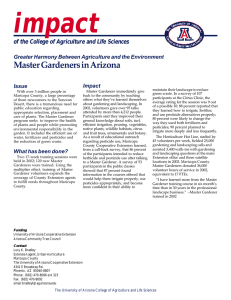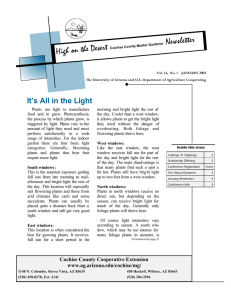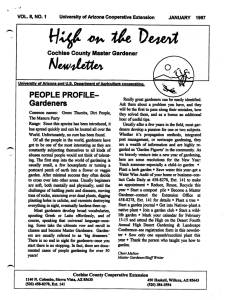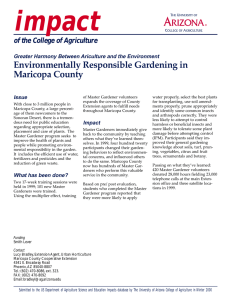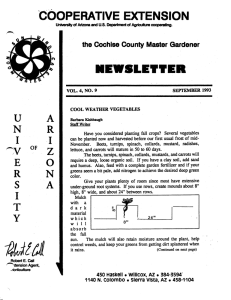Newsletter High on the Desert
advertisement
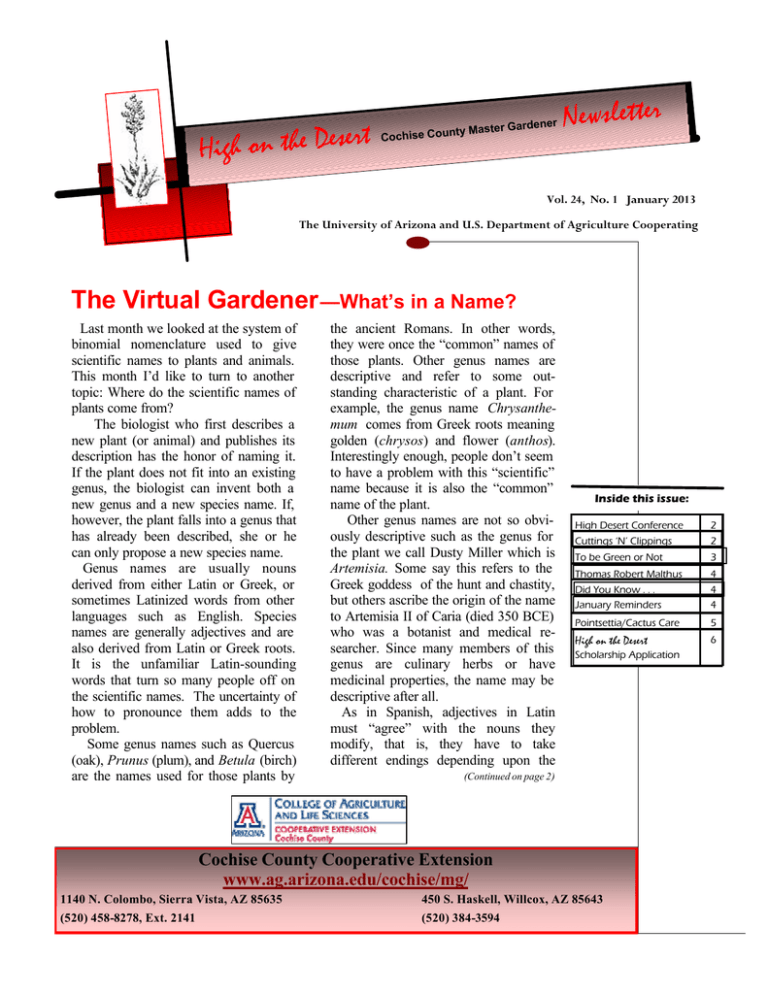
High on the Desert ardener nty Master G Cochise Cou Newsletter Vol. 24, No. 1 January 2013 The University of Arizona and U.S. Department of Agriculture Cooperating The Virtual Gardener —What’s in a Name? Last month we looked at the system of binomial nomenclature used to give scientific names to plants and animals. This month I’d like to turn to another topic: Where do the scientific names of plants come from? The biologist who first describes a new plant (or animal) and publishes its description has the honor of naming it. If the plant does not fit into an existing genus, the biologist can invent both a new genus and a new species name. If, however, the plant falls into a genus that has already been described, she or he can only propose a new species name. Genus names are usually nouns derived from either Latin or Greek, or sometimes Latinized words from other languages such as English. Species names are generally adjectives and are also derived from Latin or Greek roots. It is the unfamiliar Latin-sounding words that turn so many people off on the scientific names. The uncertainty of how to pronounce them adds to the problem. Some genus names such as Quercus (oak), Prunus (plum), and Betula (birch) are the names used for those plants by the ancient Romans. In other words, they were once the “common” names of those plants. Other genus names are descriptive and refer to some outstanding characteristic of a plant. For example, the genus name Chrysanthemum comes from Greek roots meaning golden (chrysos) and flower (anthos). Interestingly enough, people don’t seem to have a problem with this “scientific” name because it is also the “common” name of the plant. Other genus names are not so obviously descriptive such as the genus for the plant we call Dusty Miller which is Artemisia. Some say this refers to the Greek goddess of the hunt and chastity, but others ascribe the origin of the name to Artemisia II of Caria (died 350 BCE) who was a botanist and medical researcher. Since many members of this genus are culinary herbs or have medicinal properties, the name may be descriptive after all. As in Spanish, adjectives in Latin must “agree” with the nouns they modify, that is, they have to take different endings depending upon the Inside this issue: High Desert Conference 2 Cuttings ‘N’ Clippings 2 To be Green or Not 3 Thomas Robert Malthus 4 Did You Know . . . January Reminders 4 4 Pointsettia/Cactus Care 5 High on the Desert 6 Scholarship Application (Continued on page 2) Cochise County Cooperative Extension www.ag.arizona.edu/cochise/mg/ 1140 N. Colombo, Sierra Vista, AZ 85635 450 S. Haskell, Willcox, AZ 85643 (520) 458-8278, Ext. 2141 (520) 384-3594 PAGE 2 (Continued from page 1) gender and other grammatical properties of the noun they modify. This explains why two species names associated with different genus names may be spelled differently even when they mean the same thing. For example, the scientific name of the wild sweetpea is Lathyrus (derived from the Greek word for “pea”) arizonicus (referring to the state of Arizona). The scientific name for the Arizona rose is Rosa (originally from the Latin name for these flowers) arizonica (referring to the state). Both species names refer to Arizona but are spelled differently because they have to “agree” with their associated genus names which have different grammatical properties. The species of many plants are derived from the names of people, often the botanist who named them. We see examples of this in many of the plants of our own region. The cottonwood, Populus fremontii, is named after John Charles Fremont (1813-1890), the famous solider, explorer, and naturalist who was once governor of Arizona Territory. The catclaw, Acacia greggii, is named for Josiah Gregg (1806-1850), a frontier trader and author who traveled widely in northern Mexico and the Southwest. There are numerous other examples. Species names for most plants describe some aspect of the form or habitat of the plant. For example, one of the eucalyptus trees that flourishes in this area is Eucalyptus microtheca. The species name, microtheca comes from the Greek roots, micro and theca meaning small seed. Similarly the species names microphyllum or microphylla , both come from the Greek roots meaning small leaf. The palo verde, Cercidium microphyllum, and the Texas mulberry, Morus microphylla , are both aptly described as having small leaves. If you are interested in finding out more about the names of plants, there are many places to look. One of the easiest is your dictionary which has a lot of information about the origin of the scientific names of plants and animals. A popular book from Dover Publications by Liberty Hyde Bailey called How Plants Get Their Names contains a wealth of information on the subject. And of course you can search the internet. Wikipedia is especially useful for this purpose. Until next time, happy surfing. Gary A. Gruenhagen, Master Gardener virtual gardener@cox.net High Desert Gardening & Landscaping Conference High on the Desert February 14 & 15, 2013 Plan now to attend!!! The Cochise County Master Gardeners Association is planning their 20th annual High Desert Gardening & Landscaping Conference to be at the Windemere Hotel & Conference Center in Sierra Vista. There will be outstanding speakers on subjects from vegetable gardening, environmental stewardship, to landscaping and plants! The conference is open to the public and is an educational experience for everyone with an interest in gardening. Scholarships are available—see back page of this newsletter for information. Click here to go to a web page with all the information on the conference including the program and registration form. Cuttings ‘N’ Clippings T The Thursday, January 3 CCMGA meeting speaker will be Master Gardener Tom Hansen. He built a greenhouse in his backyard and is working on his second. He says he learned a great deal from building the first and can give others tips on what to do and what not to do. Come hear this informative talk that may inspire you to consider making a greenhouse in your own back yard. The location is the Public Meeting Room at UAS and the time is 5:00 p.m. For information call (520) 4588278, Ext 2141 or contact Joyce at jwilliam@ag.arizona.edu/ T The next FREE Water Wise workshop is scheduled for Saturday, January 5 from 9:00 to 10:00 a.m.. will be Fort Huachuca Water Conservation Efforts—Too Successful? presented by Kim Mulhern, Chief, Environmental Division, Ft. Huachuca. Ft. Huachuca has been at the cutting edge of implementing new conservation technologies in their efforts to preserve ground water use. Come learn about some of the ways the fort is conserving, reusing, and recharging water and what surprises come with being too successful with indoor conservation practices. The location is the Public Meeting Room at UAS. For information call (520) 458-8278, Ext 2141 or contact Joyce at: jwilliam@ag.arizona.edu/ PAGE 3 To Be (Green) or Not To Be (Green) Part 1 of 2 Let me be clear right away. I believe being “green” is a very good thing. It’s imperative for us to be good stewards of the earth and to leave it in good shape for future generations. Since my earliest memories, I have been “green.” My childhood was spent in tiny communities where the wilderness was literally right across the street or out the back door. My campsites were always left cleaner than they were on arrival. I’ve always chosen cars that got good gas mileage. Heck, that kept money in my pocket— and ain’t money green?! Since becoming a gardener, I’ve striven to avoid using poisons on my plants and on my property. Routinely putting poison on my food or in my house or yard just makes no sense to me. Our house hasn’t been sprayed for insects in almost 40 years and we do not have a “bug problem.” Organic, green, conventional, “chemical”; it’s a complex set of issues. Fortunately, those of us living in Cochise County and surrounding areas will have a chance to hear a panel of speakers address some of these issues. The Thursday morning General Session of our upcoming High Desert Gardening & Landscaping Conference (Feb. 14 & 15, 2013 at the Windemere Hotel & Conference Center in Sierra Vista), will feature a two hour session with a panel presentation on “food and agriculture,” followed by a Q & A session with conference participants. Three speakers are from the University of Arizona and the fourth is from the Arizona Farm Bureau. The moderator will be Cochise County Supervisor Richard Searle. In the Friday morning General Session of the conference, Dr. Jeff Gillman, Associate Professor at the University of Minnesota, will speak for two hours on these subjects, which are the basis of two books he has authored: The Truth About Organic Gardening and The Truth About Garden Remedies. Both books are thought-provoking and informative with respect to the debate between organic and conventional gardening techniques. I hope you will choose to attend the conference to hear the talks, gather more information, and make up your own mind. I admit to being somewhat torn over the concept of “organic” gardening, in large part because what passes for information in the organic vs. “chemical” debate doesn’t seem to stand much scrutiny. Extremists justify their positions very selectively, ignoring any evidence that doesn’t support their position and repeating things that simply aren’t justified. We forget that even Rachel Carson, author of the classic Silent Spring, didn’t favor eliminating all pesticide usage. Nonetheless, it disturbs me to see folks out spraying their property on a weekly or monthly basis. So, what to do in order to be “green?” To begin with, the word “green” is fairly meaningless, although, much like pornography, we believe that we know it when we see it. Dr. Patrick Moore, one of the founders of Green Peace, said in a February 2010 radio interview on energy sources that we should think instead in terms of “cost effective,” “clean,” “renewable,” and “sustainable.” He expanded his thoughts by explaining that using wood as a fuel is cost effective, renewable, and sustainable (if we replant trees in adequate amounts), but it isn’t clean. Nuclear energy is cost effective, reasonably clean (uranium fuel is mined and the waste must be stored) and sustainable (for many millennia), even though uranium isn’t renewable. Coal is cheap, but its filthy and ultimately it isn’t renewable or sustainable. Solar energy in the form of photovoltaic cells is reasonably clean (materials for solar panels are also mined and also not renewable), but it isn’t yet cost effective. Using solar energy to heat water, on the other hand, is cost effective, clean, and sustainable. With regard to gardening, I would change the “clean” on Dr. Moore’s list to “toxicity,” although strictly speaking toxicity is simply a different way of saying clean. Is synthetic fertilizer OK? Well, it is cost effective and non-toxic when applied properly, but it isn’t otherwise particularly clean as it involves mining for elements like potassium and phosphorus, or burning of fossil fuels to produce nitrogen. It isn’t renewable nor sustainable in the long run, either. Bill Schulze, Master Gardener billwithccmga@gmail.com PAGE 4 Master Gardeners save the date 3/11/2013 Thomas Robert Malthus Thomas Robert Malthus was renowned for his theories on population and its effects on society and his belief that we would eventually run out of resources to sustain ourselves. He believed that we would survive all the world’s problems, but that nature had ways of controlling population through disease, war, and crime. His ideas are as controversial today as they were in 1798 when he first promulgated them. Malthus was born at Dorking, England on February 14, 1766. He was educated by his father and tutors and then went on to Jesus College, Cambridge where he did remarkably well in English, Mathematics, Latin, and Greek. He obtained a Master’s degree in 1791 and took orders in 1797. He became a curate for the Church of England in 1798. On April 12, 1804 Malthus took his cousin Harriet as his wife. He then became a professor at East India Company College, or Haileybury as we know it today, where he taught History and Political Economy. His students fondly called him “Pop” standing for “Population Malthus” due to his extensive writings on population and its effects on society. Malthus wrote his discourse called An Essay on the Principle of Population between the years of 1798 and 1826. His argument stated that history proved population growth would increase faster than the rate of resources needed to sustain that population therefore relegating that population to poverty, famine, and other distress. In other words, society would grow faster than it could produce food and other resources necessary for survival. Malthus also argued that the only way this could be controlled is by what he called positive checks, such as famine, war, and disease, which increase the death rate, or preventative checks such as birth control, abstinence, or marrying later in life, which decrease the birth rate. In addition, Malthus argued against any idea that said we could improve and expand agriculture exponentially. He believed there was a limit to these resources and, although we do not know where that limit is, we will eventually meet it. Many critics such as Karl Marx stated that Malthus did not understand the ability of humans to improve agriculture and increase the amount of food production. The industrial revolution was in full swing and many agricultural improvements were being made. Many believed we would be able to sustain ourselves due to the improvements being made in our agricultural system. The arguments and concerns posed by Malthus in the late 18th and early 19th century are just as much a concern to us today as they were then. One only needs to turn on the news, NPR, or pick up a newspaper or environmental publication to see that we are still discussing these issues. Can we continue to populate as fast or faster than we are and still be able to support ourselves agriculturally? Next month: Was Malthus right or wrong? Stephanie Blanchette Master Gardener Cochise County Master Gardener Newsletter Editor Carolyn Gruenhagen for the 2013 Sonoran Desert Master Gardener Conference The first annual conference designed specifically for the continuing education of Master Gardeners and focused on the Sonoran Desert will be presented by the University of Arizona College of Agriculture and Life Sciences Cooperative Extension Master Gardener Program. Invitation and registration information to follow. Did You Know . . . Arizona State Symbols Bird: cactus wren Tree: palo verde Flower: saguaro cactus blossom Gemstone: turquoise Neckwear: bola tie Fossil: petrified wood Mammal: ringtail Reptile: AZ ridge-nosed rattlesnake Amphibian: AZ treefrog State songs: Arizona and Arizona March Song - Google January Reminders ♦ ♦ ♦ ♦ ♦ ♦ ♦ ♦ Winter prune Remove old mulch/replace Dig tree holes Prepare soil for spring Water periodically Stratify seeds Fertilize asparagus General garden clean-up PAGE 5 Poinsettia and Christmas Cactus Care After the Holidays P o i n s e t t i a (Euphorbia pulcherrima)—This is a tropical plant that originated in Mexico. They were made popular by the first U.S. Ambassador to Mexico, Dr. Joel Roberts Poinsett. He introduced America to the poinsettia in 1828 after discovering it in the wilderness in southern Mexico. The plant is named after him, but in Mexico it is known as “flores de noche buena” or "flowers of the holy night.” As a member of the Euphorbia family they have white latex sap, and skin irritation may occur from the sap. Consumption of plant tissue is not fatal but may cause a stomach ache! Bright, indirect sunlight is required by the poinsettia. Dim light or darkness will shorten the plant’s life. Water when the soil surface feels dry to the touch. If a poinsettia is allowed to wilt, its life span will be shortened. Watering should insure the entire root ball is moistened. Poinsettias should not be allowed to sit in water because their roots are very prone to root rot caused by suffocation. Ideal temperatures do not exceed 72° F during the day and 65° F at night. Plants do well in high humidity environments. Low humidity and temperatures over 75° F are detrimental to poinsettia plants. Beware of placing plants near heat vents, on top of televisions, or near other heat producing devices. Drafty areas or sud- den changes from hot to cold should be avoided. “Spoonfeeding” the plant with soluble houseplant fertilizer diluted 1/8 1/4 of recommended strength at each watering will help maintain a healthy plant after the holidays. During the winter months less sunlight and cooler indoor temperatures will slow plant growth. Therefore, the amount of fertilizer should be decreased then as well. After the colorful bracts fall (these are not flowers), place the plant in a cool room and let the soil nearly dry until spring. During spring repot the plant in new soil and cut back the stems to six inches above the pot rim. Move to a sunny location, water well, and watch for new growth. Add soluble fertilizer ¼ - ½ strength at each watering. Pinching back terminal growth encourages branching and more “blooms.” Poinsettias are short- day plants, meaning “flowering” is induced as day lengths shorten. To insure holiday color returns keep plant in absolute darkness from sundown to sunup for ten weeks, beginning in October. If all of this is too much bother, the old plant can be placed in the compost bin or discarded and a new one purchased for the next holiday season. Christmas cactus — There are several “holiday” cacti. They are: Christmas cactus (Schlumbergera bridgesii), having smooth leaf margins or edges; Thanksgiving cactus (S. truncata ), that blooms earlier, has saw-tooth leaf margins and two oppositely pointed tips at the end of each leaf; and Easter cactus (S. gaertneri), which blooms naturally in the spring and has smooth leaf margins. These cacti species originate in the Brazilian jungle. They grow naturally as epiphytes in branches and bark of trees. Grow these cacti as houseplants, fertilizing and watering as other cactus species. These plants are short-day plants like poinsettias. Flowering is initiated by cool temperatures (45 to 55° F), drier soil, and naturally shorter days of spring or fall. If a Christmas cactus did not bloom it is because one or more of these conditions were not met. To induce flowering, determine the type of cactus species. Ten weeks before blooms are desired, place the plant in a cool, dark closet or cupboard from sundown to sunup. Never let any light reach the plant during seclusion. Keep the soil drier than normal. Once flower buds are set the seclusion practice can cease and increase watering. Source: Houseplants. The American Horticultural Society, 1980, pp. 81 and 85. (Note: Reprinted from the January 1993 Cochise County Master Gardener Newsletter written by Robert E. Call, Horticulture Agent.) Issued in furtherance of Cooperative Extension work, acts of May 8 and June 30, 1914, in cooperation with the U.S. Department of Agriculture, Jeffrey C. Silvertooth, Associate Dean & Director, Economic Development & Extension, College of Agriculture and Life Sciences, The University of Arizona. The University of Arizona is an equal opportunity, affirmative action institution. The University does not discriminate on the basis of race, color, religion, sex, national origin, age, disability, veteran status, or sexual orientation in its programs and activities. The information given herein is supplied with the understanding that no discrimination is intended and no endorsement by Cooperative Extension is implied. Any products, services, or organizations that are mentioned, shown, or indirectly implied in this publication do not imply endorsement by the University of Arizona. PAGE 6 l time! l i t s s ’ e ! Ther HURRY High on the Desert High Desert Gardening & Landscaping Conference Scholarship Application The Cochise County Master Gardeners Association (CCMGA) is awarding up to three full scholarships (value $100 each) to the 2013 High Desert Gardening & Landscaping Conference to be held at the Windemere Hotel & Conference Center, Sierra Vista, AZ, February 14 & 15, 2013. Applicants are invited to submit an essay on one of the following topics: Gardening for food production Landscaping with native plants Environmental stewardship Essays must meet the following criteria: 1. 750 to 1,000 words in length. 2. Represent original scholarship and be suitable for publication. All references and authorities cited must be properly attributed. 3. Please submit as an attachment (plain text format) to an e-mail to ccmgasecretary@gmail.com Subject: Conference Scholarship. 4. Entries must be received not later than close of business on January 11, 2013 Entries will be judged by a committee of Master Gardeners appointed by the President of CCMGA. The awardees will be notified not later than January 25, 2013. By submitting your entry you understand that it becomes the sole property of Cochise County Master Gardeners Association and may be published in the Cochise County Master Gardener Newsletter*. ---------------------*The Cochise County Master Gardener Newsletter is a publication of the University of Arizona Cooperative Extension.

